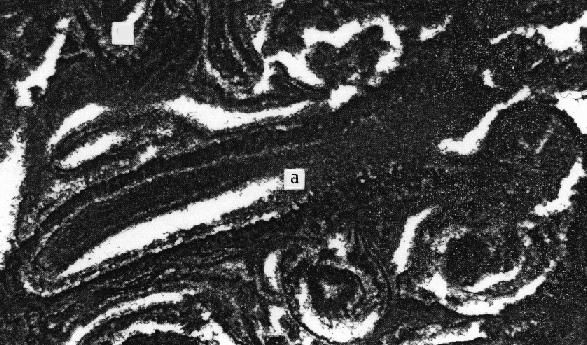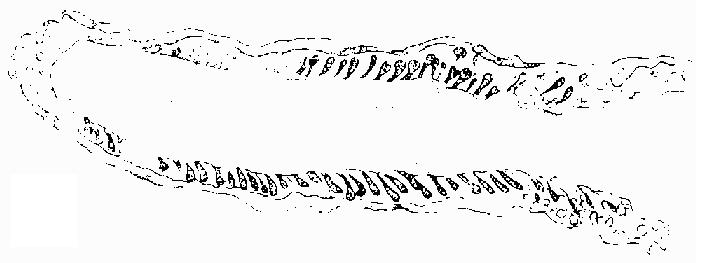FAMILY TRIPLOPORELLACEAE
TRIBE GYROPORELLEAE
GENUS Gyroporella (GÜMBEL 1872) BENECKE 1876
SPECIES Gyroporella plumosa (ZANIN BURI 1965) BRAGA 1986
![]()
(by J.C. Braga)
1. Synonymy list
1965a Gyroporella vesiculifera var. plumosa n. var.- Zanin Buri, Pl. 48.a = Pl. 51, fig. 3; Pl. 48.b
1986 Gyroporella plumosa n. stat.- Braga, Fig. 2.h-k & 2.p
1987 Gyroporella plumosa.- Braga & Martin, Pl. I, fig. 9
2. Type
holotype: Pl. 48.a = Pl. 51, fig. 3, thin section N° MB-366, Coll. N° 1568, Collection C. Zanin Buri, Laboratorio di Micropaleontologia, Istituto di Paleontologia, Universitį di Milano (Italy)
type locality: Valle Imagna, Erve, NW Bergamo, Lombardia (Italy)
stratum typicum: Norian (Dolomia Principale/Hauptdolomit)
3. Diagnosis
(none)
4. Descriptions
Original description (Zanin Buri, 1965a): « Nell'aspetto esterno essa č del tutto simile alla forma tipica di Gyroporella vesiculifera. Purtroppo lo stato di conservazione del campione che ho in esame non č buono ed il tallo č ben visibile soltanto in pochi individui. La forma č cilindrica, con un accenno di curvatura. In una sezione longitudinale leggermente obliqua esso presenta nella parte superiore una specie di strozzatura di piccola entitą, quindi una sensibile svasatura verso l'alto (v. Tav. 48, a): in corrispondenza della svasatura si ha un notevole ispessimento dello scheletro. In ogni altra parte lo scheletro č sottile, mentre il canale centrale č piuttosto ampio.
La forma dei rami č vesiculifera e pertanto chiusa all'esterno. Tali rami possono essere lunghi e snelli e tendere ad un aspetto claviforme.
La differenza sostanziale tra la forma tipica di Gyroporella vesiculifera e la nuova varietą consiste perņ nella disposizione dei rami, che nella prima č rigorosamente perpendicolare alla cellula assiale, mentre nella seconda č fortemente obliqua (4O°-45°) verso l'alto, conferendo in tal modo allo scheletro un aspetto quasi piumoso (v. Tav. 48, a e Tav. 51 fig. 3).
La sezione trasversale del tallo presenta molto spesso un contorno festonato, qualche volta solo dal lato esterno, altrimenti anche da quello interno. I pori vi sono disposti come grani di rosario, ravvicinati gli uni agli altri (v. Tav. 48, b). »
New description (Braga, 1986): « Finger-like thalli usually slightly bent. They are up to 16 mm long in the studied samples. Thallus diameter variable even in the same plant as they narrow towards both extremes. It ranges from 775 to 2440 microns (mean 1310). Primary branches only, not arranged in whorls. They are vesiculiferous with ill-defined claviform vesicles which distally end in a very narrow pore. Their lenght ranges between 190 and 425 microns (mean 337). The maximum diameter of branches is slightly smaller in the extremes of the thallus and wider in the central portion of the plant. It ranges from 75 to 135 microns (mean 92) and is also variable between plants (Fig. 2...). Branches spread upwards at angles from 30 to 70 degrees (mean 60) to the inner surface of the wall. Calcified wall thickness very variable, ranging from 150 to 440 microns (mean 230). This variation shows no correlation with thallus diameter (Fig. 2...) although wall thickness is proportionally higher at smaller diameters in the same plant. One way ANOVA (Analysis of variance) shows significant differences in wall thickness between samples coming from different localities and/or stratigraphic levels, pointing to a paleonvironmental or diagenetic control of this feature. External surface of the calcified wall scalloped and sometimes segmented in transversal and axial sections. »
Measurements (Zanin Buri, 1965a): « Dimensioni (in mm):
|
D |
d |
d/D (%) |
|
Esemplare maggiore |
3,2 |
2,4 |
75 |
Esemplare medio |
2,1 |
1,5 |
71~ |
Esemplare minore |
1,2 |
0,8 |
66 |
Le dimensioni dei rami vanno da un minimo di mm 0,04 per lo stelo ad un massimo di 1,1 mm per la vescichetta.
I talli presentano tutte le dimensioni intermedie tra quelle sopra indicate e nessuna di esse č predominante rispetto alle altre. Il valore del rapporto d%/D oscilla entro limiti molto ristretti e si aggira sempre attorno al 70 %. »
5. Remarks
Zanin Buri (1965) first described this taxon as a variety of Gyroporella vesiculifera Gümbel. The main diagnostic character of the taxon, the upward inclination of the branches, was considered by Braga (1986) differential enough to elevate it to the species rank, according to the current taxonomical procedures in fossil Dasycladales.
6. Stratigraphic range
Norian (Zanin Buri, 1965a; Braga, 1986; Braga & Martin, 1987)
7. Real distribution
Italy (Zanin Buri, 1965a), Spain (Braga, 1986; Braga & Martin, 1987)
8. Paleoecology
|
9. Figures |
« Olotipo » from Zanin Buri, Pl. 48.a |
|
« Olotipo » from Zanin Buri, Pl. 51, fig. 3 |
||

